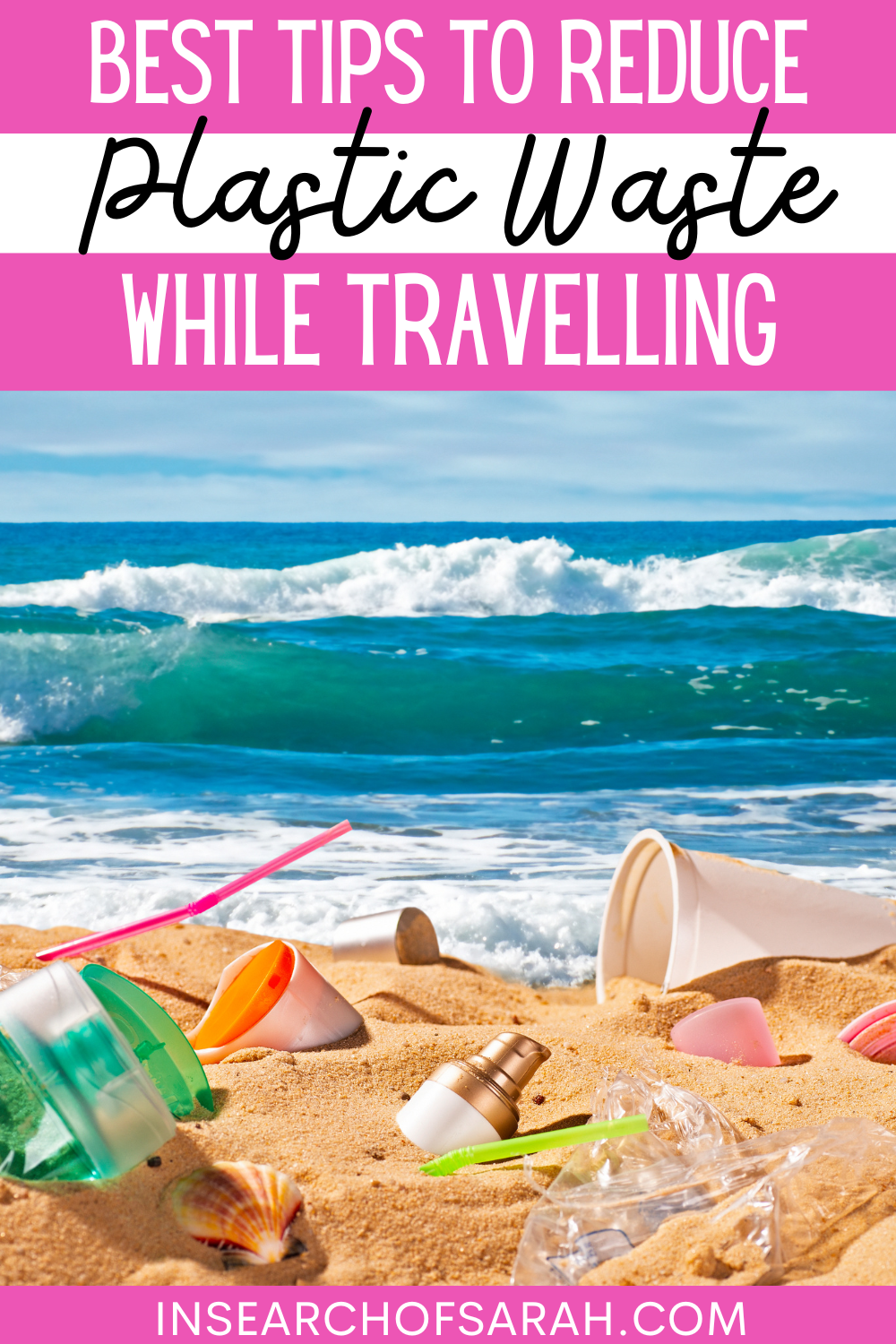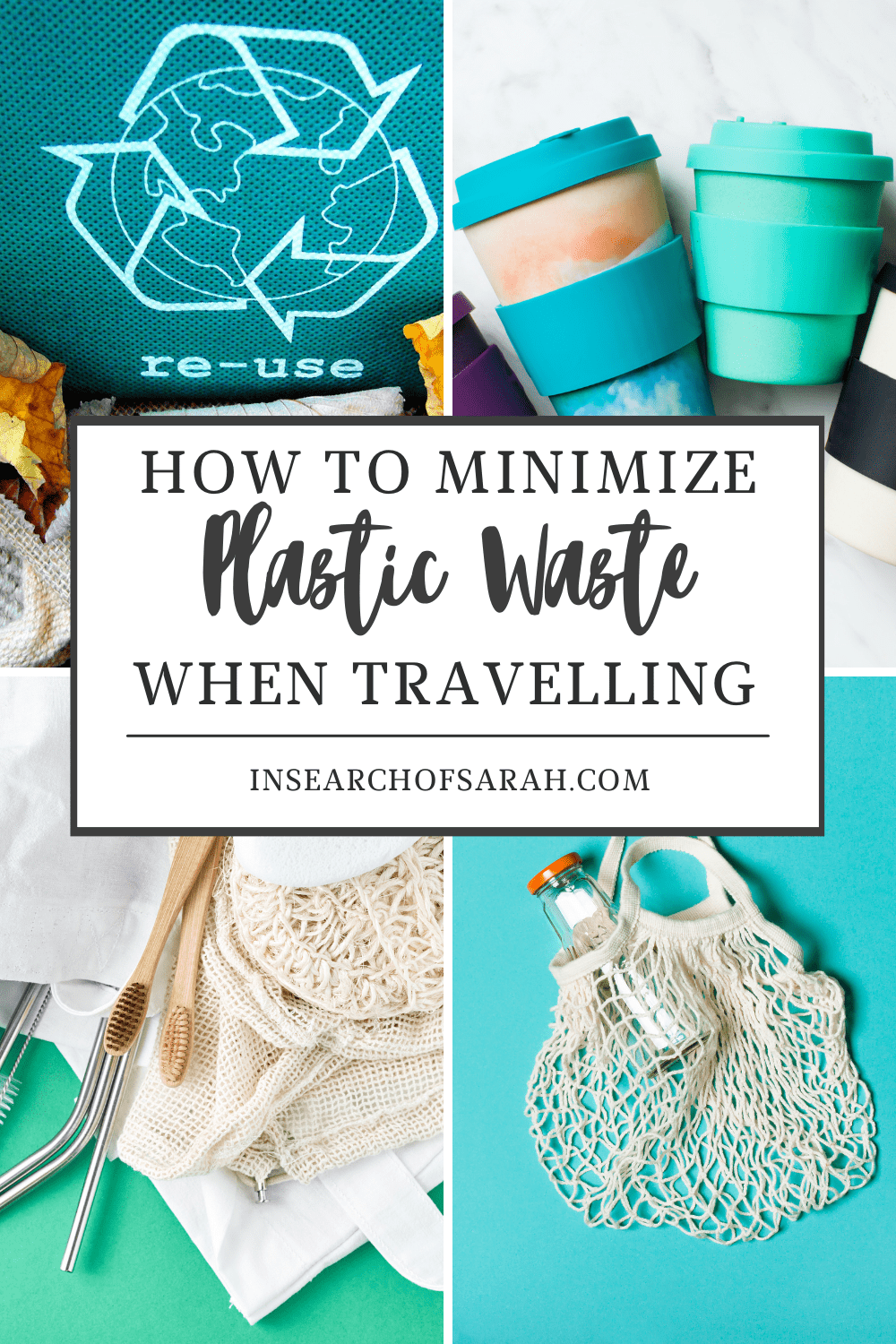Travelling is an exciting experience that allows us to explore new destinations, cultures, and cuisines. However, the impact of travel on the environment is undeniable, with plastic waste being a major concern.
The International Air Transport Association (IATA) estimates that the average passenger produces 3.15 pounds (1.43 kg) of trash during a single flight. All passenger flights taken together generate more than six million tons of trash per year.
While it’s easy to adopt sustainable habits at home, reducing plastic while travelling can be challenging, especially due to the prevalence of single-use plastics in planes.
Let’s check out some of the best tips on how to minimize waste while on the go, especially plastic waste!
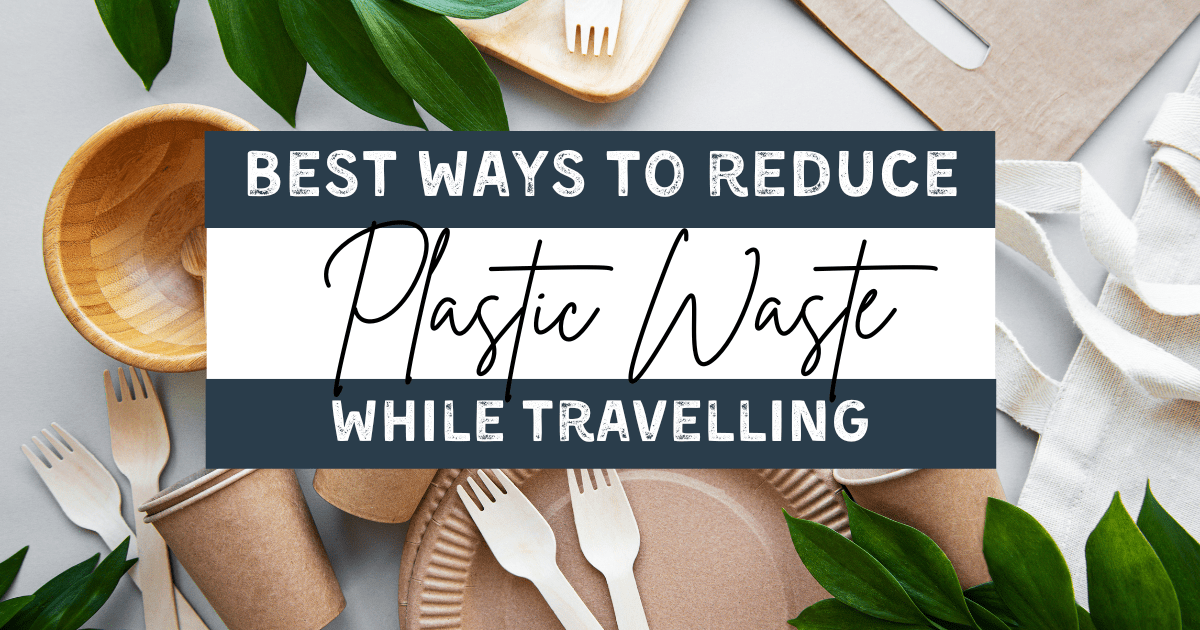
This post contains affiliate links which means I earn compensation when you click on the links at absolutely no extra cost to you! Feel free to read my disclosure policy. Thank you for supporting my blog!
Interested in purchasing some of these sustainable travel products from SWOP – Shop Without Plastic listed in this blog? Use code INSEARCHOFSARAH to save 15% off your purchase!
Travel Tips to Reduce Plastic Waste
Bring reusable items
Before leaving for your trip, make sure to pack reusable items such as a water bottle, coffee cup, utensils, and a bag for shopping. By bringing your own reusable items, you can avoid using single-use plastics.
Water bottle
Make sure you always have your water bottle with you. If you’re travelling by plane just keep the empty bottle in your hand luggage and fill it as soon as you’re through security.
Most airports and many cities have water refill stations that offer filtered drinking water for free. Not only do you save water, you also don’t have to rely on buying the overpriced water at the airport.
Coffee mug
Just like your water bottle, taking your refillable coffee cup can save tons of plastic while travelling. Even during the flight, you can just ask for a refill instead of taking the many plastic- and paper cups that are offered by most airlines.
Cutlery
Travel cutlery is another sustainable alternative that can help reduce plastic waste while travelling. Disposable plastic cutlery is a major contributor to the plastic pollution problem, as they are used for only a few minutes before being thrown away.
However, there are many options for reusable travel cutlery made from wood or metal that can be used again and again.
Bring a reusable straw
It is estimated that up to 8.3 billion plastic straws are polluting the world’s coastlines right now. Using reusable straws while travelling is an easy and effective way to reduce plastic waste.
Instead of using single-use plastic straws, which often end up in landfills or the ocean, metal or bamboo straws can be used repeatedly and are easy to clean. Plus, they are compact and lightweight, making them perfect for travel.
Simply pack them in your bag or purse and bring them out whenever you order a drink. Some metal straws even come with a cleaning brush and carrying case, making them even more convenient to use while on the go.
As an additional advantage, your reusable straws limit the risk of receiving contaminated straws and contracting stomach diseases.
Shopping bag
Surprisingly, shopping without plastic can be a lot easier in many developing countries, as most people are used to buying groceries and fresh produce on the market. By bringing your reusable shopping bag or having your backpack ready, you always have a sustainable option for your groceries.

Related: Scrubba Wash Bag Review – Travel With a Portable Washing Machine!
Take sustainable toiletries
Especially when you travel long distance routes, you’ll want to have some toiletries handy to freshen up during flight or layover. One way to make sustainable travel even more convenient is by incorporating solid toiletries into your packing list.
Solid toiletries are a life hack for sustainable travel because they not only reduce waste, but they also do not count towards the liquid 1-litre limit in planes, making them easy to travel with.
Here are some sustainable toiletries to consider packing on your next trip:
Solid Deodorant
Traditional deodorant comes in plastic packaging that can contribute to the growing plastic waste problem. Solid deodorant, on the other hand, often comes in a small metal or cardboard tube and can last for months. Plus, it won’t count towards your liquid allowance when flying.
Toothpaste Tablets
Around 20 billion single-use toothpaste tubes are produced every year. As they take 500 years to break down and they mostly are non-recyclable, toothpaste tubes contribute significantly to our plastic waste problem.
Toothpaste tablets, however, are a sustainable alternative. They often come in a small travel box and can be chewed to create foam, just like regular toothpaste. They’re also lightweight and won’t add to your liquid allowance when flying.
Interested in purchasing some of these sustainable travel products from SWOP – Shop Without Plastic listed in this blog? Use code INSEARCHOFSARAH to save 15% off your purchase!
Solid Shampoo & Conditioner
Traditional shampoo and conditioner often comes in plastic bottles that can be difficult to recycle. Solid bars are a sustainable alternative that often comes in cardboard packaging or functional travel boxes. They’re lightweight and you can pack as much as you like without worrying about the liquid allowance.
Solid Soap
Similarly, shower gel often comes in plastic bottles that can contribute to plastic waste. Solid soap, on the other hand, can last for months and often comes in cardboard packaging. Together with your shampoo, you’ll always be able to refresh on the go without worrying about too much liquid in your hand luggage.
Bamboo Toothbrush
In addition to your solid toiletries, make sure you bring your bamboo toothbrush. Plastic toothbrushes can take up to 500 years to decompose in landfills. A bamboo toothbrush, however, is biodegradable and sustainable. They often come in a small travel case and won’t take up much space in your luggage.
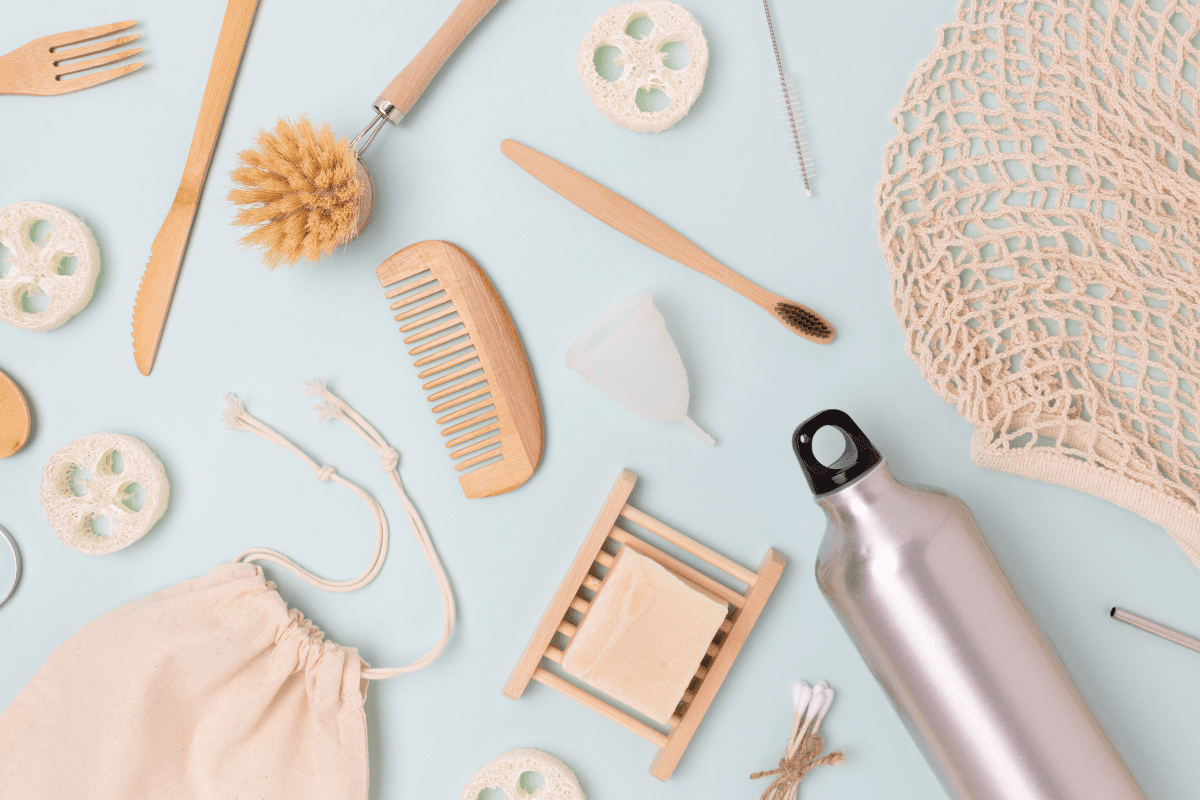
Bring a water filter
Avoiding single-use plastic while traveling can be challenging, especially when it comes to safe drinking water. Many travelers opt for plastic bottles, even in areas where tap water is safe to drink, out of fear of getting sick.
However, Reuters reports that 1 million plastic bottles are bought worldwide every single minute, most of them ending up on a landfill or in nature after a few minutes. The good news is that there’s an easy solution: a portable water filter.
By incorporating a water filter into your travel routine, you can adopt an environmentally friendly lifestyle while saving money.
There are various types of filters, and you’ll likely find the one that suits your requirements. You may need to plan ahead to ensure you have enough water for the day, but with a good water filter in your backpack, you are well prepared for your adventures.
Portable filters can provide clean drinking water within minutes, whether from a public bathroom or a stream in the mountains.
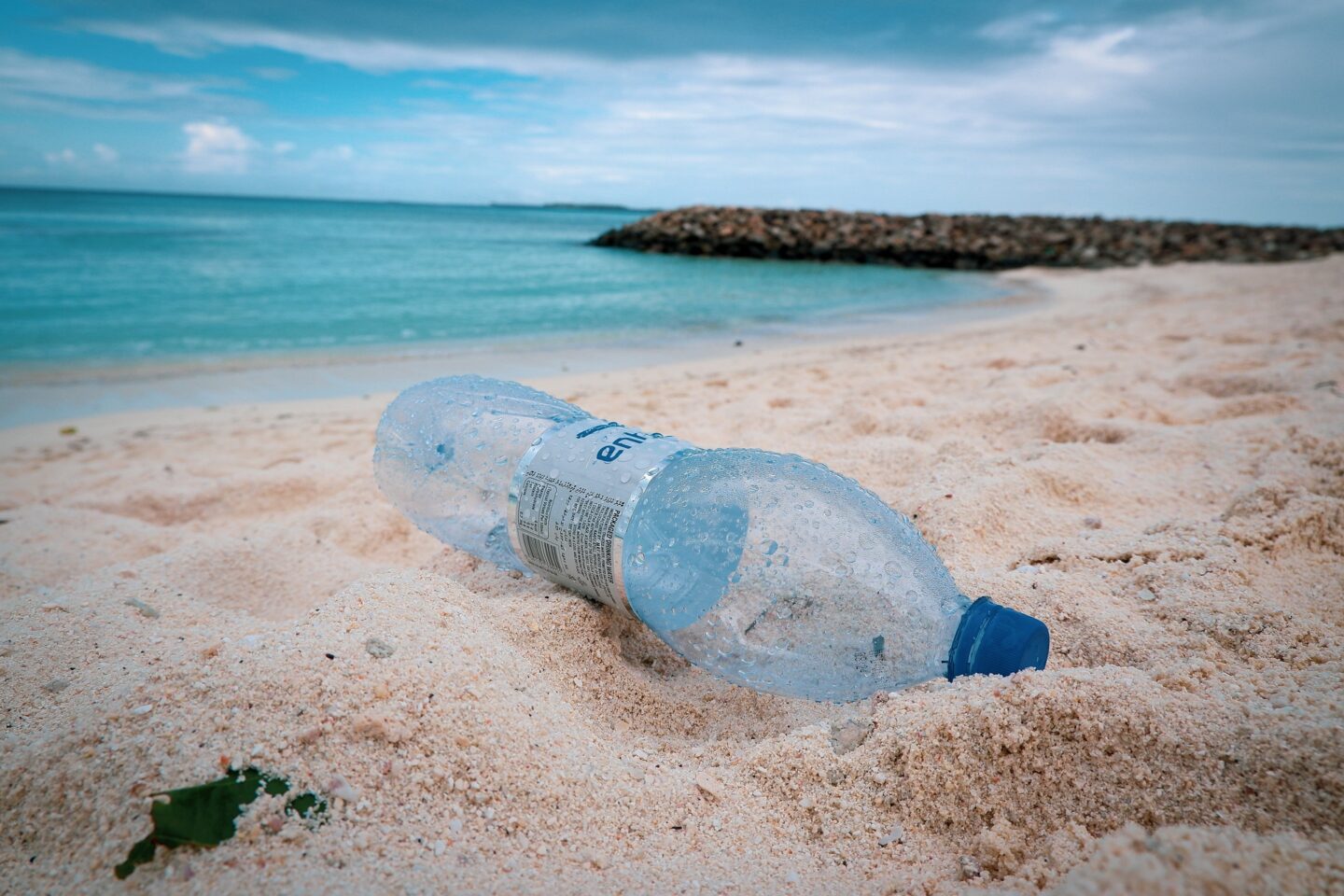
Make your travel sustainable by bringing reusable items
Reducing plastic waste while travelling is not only good for the environment but also easy to do with a few simple steps. By bringing your own reusable items, saying no to straws, and avoiding plastic toiletries, you can enjoy your travels while also making a positive impact on the planet.
While we only covered waste-conscious travelling, it is of course also favourable to pick sustainable modes of transport. If possible, trains and buses are more sustainable than flights regarding the carbon footprint.
Let us all try to be aware of our individual choices and ensure we can enjoy this beautiful world for generations to come!
Author bio: Lars is the Co-Owner of SWOP – shop without plastic, a zero-waste online shop and blog based in Toronto. He is passionate about protecting the environment and educating about plastic pollution.
Related Posts
- What to Pack for an All-Inclusive Vacation
- What to Pack in a DIY Travel Medical Kit
- 20 Cheap Travel Items Under $20 (That Are Surprisingly Useful!)
- How to Travel With a Carry-On Only
- How to Build a Travel Fund: Actionable Tips to Save for Travel
Pin it for later!
